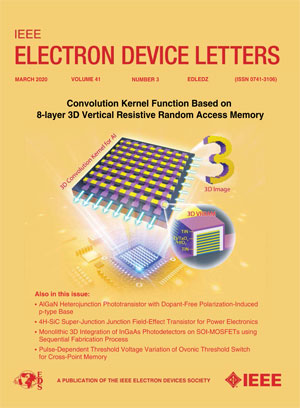Enhancement of Energy Storage and Efficiency in Antiferroelectric Hf᙮Zr᙮₋₁O₂ Supercapacitors Through Tailored Phase Engineering by Oxygen Vacancy
IF 4.5
2区 工程技术
Q2 ENGINEERING, ELECTRICAL & ELECTRONIC
引用次数: 0
Abstract
In this letter, the antiferroelectric (AFE) performance of氧空位定制相位工程提高反铁电Hf᙮Zr᙮₁O₂超级电容器的储能和效率
在这封信中,${\ mathm {Hf}} {\mathbf {x}}$ ${\ mathm {Zr}} {\mathbf {{1}-}\mathbf {x}}$ ${\ mathbf {O}} {\mathbf {{2}}}$ (HZO)薄膜的反铁电(AFE)性能通过调节氧空位(V ${}_{\ \mathbf {\!\!\mathbf{0}}$)。在HZO薄膜溅射过程中使用不同${\ mathm {O}}_{\mathbf{{2}}}$流量的气体。引入适当的${\ mathm {O}}_{\mathbf{{2}}}$流可以提高AFE HZO储能电容器的储能密度(ESD)和效率($\eta $)。x射线衍射(XRD)和电容量(C-E)测试表明,HZO薄膜中的t相/o相比可以通过调节V ${}_{\!\!\mathbf {O}}$浓度促进t相结晶。当V = 8.0%时,HZO薄膜中t相的结晶效果最佳。\mathbf {O}}$, Zr浓度为0.82时,静电放电为~86.3 J/cm3,效率为~74%。此外,我们还获得了卓越的耐用性,在保持98%初始ESD的同时,循环次数超过10^{{9}}$。所得结果为制备高性能AFE HZO ESCs提供了一种新颖有效的方法。
本文章由计算机程序翻译,如有差异,请以英文原文为准。
求助全文
约1分钟内获得全文
求助全文
来源期刊

IEEE Electron Device Letters
工程技术-工程:电子与电气
CiteScore
8.20
自引率
10.20%
发文量
551
审稿时长
1.4 months
期刊介绍:
IEEE Electron Device Letters publishes original and significant contributions relating to the theory, modeling, design, performance and reliability of electron and ion integrated circuit devices and interconnects, involving insulators, metals, organic materials, micro-plasmas, semiconductors, quantum-effect structures, vacuum devices, and emerging materials with applications in bioelectronics, biomedical electronics, computation, communications, displays, microelectromechanics, imaging, micro-actuators, nanoelectronics, optoelectronics, photovoltaics, power ICs and micro-sensors.
 求助内容:
求助内容: 应助结果提醒方式:
应助结果提醒方式:


